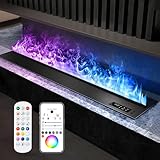This is the million-dollar question: do water vapor electric fireplaces leave residue? The short answer is it depends, mainly on the type of water you use. The vapor produced is clean in itself, but the minerals present in tap water can lead to fine white dust settling nearby. This isn’t unique to fireplaces humidifiers that use ultrasonic technology do the same thing when filled with mineral-rich water.
Do water vapor electric fireplaces leave residue?
If you’re using regular tap water in your water vapor electric fireplace, especially hard water, it contains minerals like calcium and magnesium. When the water is vaporized, these minerals don’t evaporate with it. Instead, they get left behind and can settle as a fine white film on nearby furniture, electronics, or surfaces over time. It’s not hazardous, but it can be a nuisance if left unmanaged.
So yes, residue can occur but it’s not from smoke or soot. It’s mineral dust, and the good news is, it’s completely preventable with the right practices, which we’ll dive into later in this article.
Common Concerns About Residue and Maintenance
Homeowners often notice that surfaces near the fireplace like TV screens, shelves, or glossy furniture start to collect a fine powdery film after weeks or months of frequent use. This isn’t harmful to your equipment, but it does mean you’ll need to clean a bit more often if you’re using mineral-rich water. The mist doesn’t carry scent or sticky particles, so it doesn’t attract dust in the same way a greasy cooking vapor might.
Another common concern is whether the mist can damage electronics or leave water droplets on surfaces. In well-ventilated areas, this is rarely a problem. The mist is ultra-fine and disperses quickly.
Unless the fireplace is malfunctioning or poorly maintained, it won’t form puddles or damp spots. Still, proper placement and regular cleaning will help keep everything in top condition.
Ultimately, with smart habits like using distilled water and giving the unit a light wipe every few weeks—you can keep your space residue-free.
The Science Behind Water Vapor and Residue
Minerals in Tap Water: The Hidden Culprit
Most people don’t think twice about the water they pour into their appliances, but when it comes to water vapor fireplaces, the quality of your water matters a lot. Tap water, especially if you live in a hard water area, contains a cocktail of minerals like calcium, magnesium, and sometimes iron.
These minerals are harmless to drink, but when vaporized, they don’t just disappear.
Here’s what happens: as the fireplace’s ultrasonic technology breaks water into mist, it leaves behind any non-evaporative materials—mainly those minerals. These particles are light and become airborne with the mist.
Eventually, they settle onto surfaces as a faint white dust. Over time, this residue can accumulate on floors, furniture, and even your TV screen.
The degree to which this happens depends on two things:
- The hardness of your water – the more minerals, the more residue.
- How frequently you use the fireplace – more hours means more mist and, therefore, more mineral dispersal.
So, while water vapor fireplaces don’t leave the black soot or ash that wood-burning fireplaces do, they can still leave something behind if the water source isn’t properly managed. It’s a subtle kind of residue, but it’s real—and preventable.
Evaporation vs. Combustion: Key Differences
Let’s draw a clear line between traditional combustion-based fireplaces and water vapor fireplaces. In wood-burning or gas fireplaces, the heat and fire generate smoke, ash, and a host of pollutants like carbon monoxide. These require chimneys or vents to safely expel the byproducts, and even then, your walls, curtains, and ceilings can become stained over time.
Water vapor fireplaces operate on a completely different principle: evaporation. But not even just plain evaporation it’s ultrasonic atomization. This technique breaks water into mist so fine it mimics smoke. Because there’s no actual burning involved, there’s no carbon, no soot, and no toxic gases. Just light and mist.
The key difference? Combustion leaves black grime and can affect respiratory health. Water vapor, at worst, leaves behind light mineral dust that can be wiped away. And if you switch to distilled water? That problem almost disappears altogether.
Is There a Risk of Mold or Dampness?
This is a valid concern, especially for anyone who’s dealt with humidifiers or has lived in older, less ventilated homes. Since water vapor fireplaces release mist into the air, many people wonder whether they raise indoor humidity to problematic levels. Could that lead to mold growth or a damp, musty environment?
Fortunately, the answer is no—at least not under normal usage conditions. The amount of mist released is minimal compared to full-size humidifiers.
These fireplaces aren’t meant to increase room humidity; they’re purely for aesthetics. If your room is properly ventilated, the mist evaporates into the air almost immediately.
That said, overuse in small, unventilated spaces might cause a slight uptick in humidity. If you notice windows fogging or condensation forming on surfaces, that’s a signal to either ventilate more or reduce usage time.
Like anything involving moisture, balance is key. Install the fireplace in a room with airflow, and you’ll never run into dampness or mold problems.
Effects on Furniture, Electronics, and Decor
This is where things get a bit tricky. While the mist itself is clean and safe, mineral residue from hard water can settle on surfaces. Over weeks or months, you might notice:
- A faint white film on glossy furniture or TV screens
- Slight spotting on mirrors or glass if the mist hits them directly
- Buildup on nearby electronics vents or fan intakes
None of this is dangerous, but it can be annoying if left unchecked. Over time, the residue might even reduce the clarity of glass surfaces or cause minor aesthetic blemishes.
The solution? Regular dusting and a switch to distilled water—which contains none of the minerals that cause residue. It’s affordable, widely available, and dramatically improves the performance of your water vapor fireplace.
Additionally, proper placement goes a long way. Don’t put your fireplace right under a painting, next to a fabric sofa, or near electronics that might be sensitive to moisture. Think of it like placing a decorative fountain you wouldn’t want constant mist settling on your MacBook or sound system, right?
Maintenance Tips to Prevent Any Residue
Using Distilled Water Instead of Tap Water
Here’s the golden rule for keeping your water vapor fireplace spotless: always use distilled water. This one switch can virtually eliminate the issue of mineral residue. Unlike tap water, distilled water has been boiled and condensed to remove all minerals and impurities.
That means nothing is left behind when it vaporizes no calcium, no magnesium, and absolutely no chalky film on your shelves.
You can buy distilled water in gallon jugs at most supermarkets, or, if you use your fireplace frequently, consider investing in a countertop distiller. Some homeowners even use reverse osmosis (RO) water, which is another good option as long as it’s low in minerals.
Here’s why this matters:
- Longer lifespan for your fireplace: No mineral buildup in the misting mechanism means fewer breakdowns.
- Less cleaning required: No residue on nearby surfaces.
- Cleaner “flames”: Over time, minerals can cloud the mist and distort the light effects.
While it might seem inconvenient at first, the cost of distilled water is minimal compared to the hassle of cleaning residue or repairing clogged parts. Think of it as fuel just like you wouldn’t put dirty gas in a luxury car, don’t use hard water in your premium fireplace.
Regular Cleaning Schedule for the Fireplace
Even with distilled water, a little upkeep goes a long way in keeping your fireplace looking and working like new. Aim to clean it every 2–4 weeks, depending on how often you use it. If you’re using tap water, this might need to be weekly.
Here’s a simple cleaning checklist:
- Turn off and unplug the unit.
- Empty any remaining water from the reservoir.
- Wipe down the water tank and interior surfaces with a soft cloth dampened with vinegar or a mild cleanser.
- Clean the misting transducer using a cotton swab—this part is the heart of the system and can get clogged with mineral deposits.
- Dust the external parts and any nearby furniture.
You May Also Like To Read:
Affiliate Disclosure: Fireplaceadviser.com is a participant in the Amazon Services LLC Associates Program. We may earn a commission when you click on certain links on this site and purchase.

Hello!! I am Jamal Khan. I often fix my home electric heaters and gas stove problems and research the common issues in the heating units to improve my knowledge and expertise. The aim of establishing fireplaceadviser.com is to share my expertise and knowledge with my audience.















